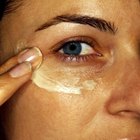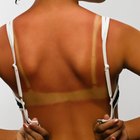
iprogressman/iStock/Getty Images
Obagi is a cosmetics company that produces products intended to help treat skin-related conditions such as wrinkles, scars, photo damage, acne spots and other blemishes. Obagi claims it heals these conditions by regenerating skin at the cellular level, which lightens and resurfaces the skin. The use of Obagi may result in one or several undesired side effects. Consult a medical professional before using Obagi products.
Sensitivity
An increase in overall sensitivity is a side effect of Obagi experienced by some users. The symptoms experienced by these users include itchiness, redness and burning upon the application area. Severe peeling is another painful and unsightly side effect. These side effects are common in products which contain the chemicals tretinoin and hydroquinone, which are in Obagi Nu-Derm cream. These chemicals may also cause reddening of the eye if you use the cream to treat skin conditions around the eye. You should try the cream on a small area of your skin before beginning full use.
Sunburn
Obagi uses hydroquinone and Retin-A to rid your skin of blemishes from acne, freckles and red marks. As a result of lightened skin, your body will be more susceptible to sun damage. Retin-A also causes heightened sun sensitivity. According to Obagi.com, sunscreen should be an part of any treatment plan because even minimal sunlight contains melanocytic activity. If you use a product called Obagi Sunfader, you must remember that this is a bleaching agent and not meant to protect your skin against sunburn. If you must be in the sun for a prolonged period of time while on an Obagi regimen, be sure to use sunscreen with a high SPF rating.
Allergic Reaction
According to the physicians prescribing information provided by Obagi.com, the Obagi Nu-Derm product contains sodium metabisulfite, which may cause serious allergic reaction in some users. If you are susceptible to sulfite allergies you may experience reactions on your skin such as hives and itching. More serious allergic reactions to sodibum metabisulfite include wheezing, anaphylaxis, and severe asthma attacks.
Related Articles

The Difference Between Retin A & Renova

The Best Facial Moisturizers for People ...

List of Retinoids

Side Effects of Certain Dri

What Is Eucerin Cream?

How to Use Vaniqa Cream

Does Retin-A Micro Gel Get Rid of ...

How to Prevent Pock Holes From ...

How to Stop Stubble Itch

How to Apply Dr. Palmer's Fade Cream

What Is Tretinoin Cream Used For?

Products Used in Maintenance on the ...

Oil of Olay & Wrinkles

Tazorac Cream & What it Does for Acne

How to Fix an Irritated Upper Lip After ...

Pros & Cons of Generic Retin-A

Estrogen in Skin Creams

Estradiol Cream & Wrinkles

What Is an Obagi Blender?

Skin Care Products That Contain ...
References
Writer Bio
Based in Long Island, N.Y., Robert Rottkamp has been writing essays on a variety of social issues and sports-related topics since 2006. Rottkamp has also penned several theatrical works as well as a short film, "Tom's Place," which was an official selection in the 2008 Los Angeles International Greek Film Festival.
Photo Credits
iprogressman/iStock/Getty Images